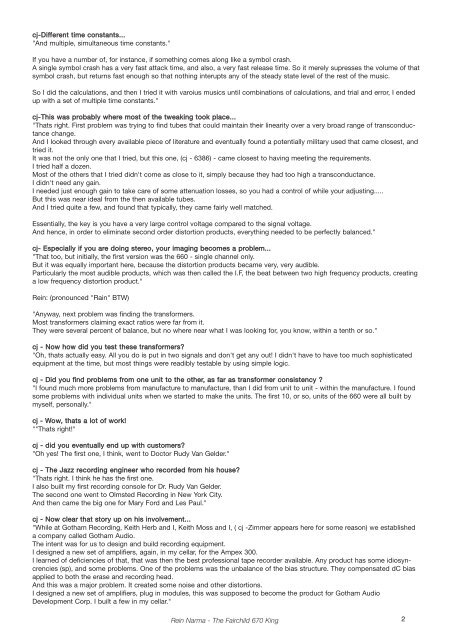Rein Narma - The Fairchild 670 King - Knif Audio
Rein Narma - The Fairchild 670 King - Knif Audio
Rein Narma - The Fairchild 670 King - Knif Audio
Create successful ePaper yourself
Turn your PDF publications into a flip-book with our unique Google optimized e-Paper software.
cj-Different time constants...<br />
"And multiple, simultaneous time constants."<br />
If you have a number of, for instance, if something comes along like a symbol crash.<br />
A single symbol crash has a very fast attack time, and also, a very fast release time. So it merely supresses the volume of that<br />
symbol crash, but returns fast enough so that nothing interupts any of the steady state level of the rest of the music.<br />
So I did the calculations, and then I tried it with varoius musics until combinations of calculations, and trial and error, I ended<br />
up with a set of multiple time constants."<br />
cj-This was probably where most of the tweaking took place...<br />
"Thats right. First problem was trying to find tubes that could maintain their linearity over a very broad range of transconductance<br />
change.<br />
And I looked through every available piece of literature and eventually found a potentially military used that came closest, and<br />
tried it.<br />
It was not the only one that I tried, but this one, (cj - 6386) - came closest to having meeting the requirements.<br />
I tried half a dozen.<br />
Most of the others that I tried didn't come as close to it, simply because they had too high a transconductance.<br />
I didn't need any gain.<br />
I needed just enough gain to take care of some attenuation losses, so you had a control of while your adjusting.....<br />
But this was near ideal from the then available tubes.<br />
And I tried quite a few, and found that typically, they came fairly well matched.<br />
Essentially, the key is you have a very large control voltage compared to the signal voltage.<br />
And hence, in order to eliminate second order distortion products, everything needed to be perfectly balanced."<br />
cj- Especially if you are doing stereo, your imaging becomes a problem...<br />
"That too, but initially, the first version was the 660 - single channel only.<br />
But it was equally important here, because the distortion products became very, very audible.<br />
Particularly the most audible products, which was then called the I.F, the beat between two high frequency products, creating<br />
a low frequency distortion product."<br />
<strong>Rein</strong>: (pronounced "Rain" BTW)<br />
"Anyway, next problem was finding the transformers.<br />
Most transformers claiming exact ratios were far from it.<br />
<strong>The</strong>y were several percent of balance, but no where near what I was looking for, you know, within a tenth or so."<br />
cj - Now how did you test these transformers?<br />
"Oh, thats actually easy. All you do is put in two signals and don't get any out! I didn't have to have too much sophisticated<br />
equipment at the time, but most things were readibly testable by using simple logic.<br />
cj - Did you find problems from one unit to the other, as far as transformer consistency ?<br />
"I found much more problems from manufacture to manufacture, than I did from unit to unit - within the manufacture. I found<br />
some problems with individual units when we started to make the units. <strong>The</strong> first 10, or so, units of the 660 were all built by<br />
myself, personally."<br />
cj - Wow, thats a lot of work!<br />
""Thats right!"<br />
cj - did you eventually end up with customers?<br />
"Oh yes! <strong>The</strong> first one, I think, went to Doctor Rudy Van Gelder."<br />
cj - <strong>The</strong> Jazz recording engineer who recorded from his house?<br />
"Thats right. I think he has the first one.<br />
I also built my first recording console for Dr. Rudy Van Gelder.<br />
<strong>The</strong> second one went to Olmsted Recording in New York City.<br />
And then came the big one for Mary Ford and Les Paul."<br />
cj - Now clear that story up on his involvement...<br />
"While at Gotham Recording, Keith Herb and I, Keith Moss and I, ( cj -Zimmer appears here for some reason) we established<br />
a company called Gotham <strong>Audio</strong>.<br />
<strong>The</strong> intent was for us to design and build recording equipment.<br />
I designed a new set of amplifiers, again, in my cellar, for the Ampex 300.<br />
I learned of deficiencies of that, that was then the best professional tape recorder available. Any product has some idiosyncrencies<br />
(sp), and some problems. One of the problems was the unbalance of the bias structure. <strong>The</strong>y compensated dC bias<br />
applied to both the erase and recording head.<br />
And this was a major problem. It created some noise and other distortions.<br />
I designed a new set of amplifiers, plug in modules, this was supposed to become the product for Gotham <strong>Audio</strong><br />
Development Corp. I built a few in my cellar."<br />
<strong>Rein</strong> <strong>Narma</strong> - <strong>The</strong> <strong>Fairchild</strong> <strong>670</strong> <strong>King</strong><br />
2


